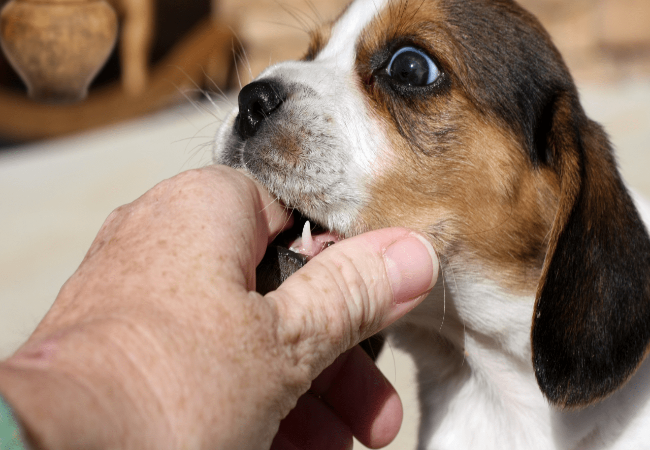Puppy Teething Care 2025: Vet Tips for Comfort, Safety & Strong Teeth 🦷🐶

In this article
Puppy Teething Care 2025: Vet Tips for Comfort, Safety & Strong Teeth 🦷🐶
By Dr. Duncan Houston BVSc
Puppy teething is an essential—but sometimes challenging—stage of development. As a veterinarian, I’ll guide you through stages, pain signs, safe chew options, dental hygiene, oral redirecting, and long-term strategies to support healthy, happy puppy mouths.
1. 📅 Timeline of Puppy Teething
Puppies go through two major teething phases:
- Deciduous (baby) teeth erupt: from ~2 weeks to ~6 weeks of age—28 sharp, “needle” teeth.
- Puppy teeth fall out, adult teeth erupt: from ~12 to ~24 weeks—leading to 42 permanent teeth.
The intense discomfort tends to peak between 12–24 weeks during adult tooth growth.
2. 😫 Signs of Teething Discomfort
Puppies express gum pain and irritation with:
- Excessive drooling
- Increased chewing or destruction of objects
- Irritability or reluctance to eat
- Nipping at people or siblings
- Chewing toys, furniture, or fingers
If they show systemic signs—fever, refusal to eat, mouth sores—consult your vet promptly.
3. ✅ Safe Chew Toy Selection
Appropriate chew toys soothe gums and protect teeth:
- For 4–12 weeks: puppy-soft toys only—avoid hard rubbers.
- For 12–24 weeks (peak teething): use:
- Soft rubber toys (KONG Puppy, Puppy Binkie) label for age/size
- Soft plush toys and teething rings (chew rings/sticks)
- Treat-dispensing toys (KONG, Busy Buddy) provide sustained chewing and mental enrichment
- Avoid hard toys and bones—they risk breaking teeth
- After 24 weeks: puppies can transition to adult-safe chew toys like durable rope and fetch toys.
4. ❄️ Soothing with Frozen Treats
Cold items numb gums:
- Offer chilled veggies like blueberries, green beans, carrots
- Freeze kibble or puppy food inside a KONG or puzzle ball
5. 🦴 Redirect Destructive Chewing
Puppies chew as play or exploration—redirect unwanted chewing:
- Swap hands/shoes with appropriate chew toy and praise
- Rotate toys to sustain interest
- Use tasty deterrents (bitter spray/tape) on forbidden items
Don’t yell or punish—this may cause fear, not learning.
6. 🧬 Nutrition & Growing Teeth
Balanced nutrition helps dental development:
- Choose formulated puppy food high in calcium and nutrients
- Avoid giving bones or hard chews during teething
- Continue monitoring diet as adult teeth finish erupting
7. 🪥 Starting Dental Health Early
Daily dental care now prevents future disease:
- Introduce brushing with soft dog toothbrush or finger brush and water
- Begin with finger gum rubs, then toothbrush and toothpaste once comfortable
- Aim for daily brushing within a few weeks
- Offer dental chew toys and treats approved by VOHC
8. 🐾 Breed & Size Considerations
- Small breeds: need softer, smaller toys to prevent tooth damage
- Large or strong-chewing breeds: more durable options, frozen KONGs
- Brachycephalic breeds: chew pace slowly, monitor temperature when freezing toys
- Anxious pups: add enriching toys and calming aids like Purrz diffusers
9. 🛠️ Tools & Supportive Services
- Ask A Vet App: chat guidance for teething pain, broken teeth, or behavior concerns
- Soft bristle toothbrush & enzymatic toothpaste for daily care
10. 🩺 When to Call the Vet
Seek vet attention if you notice:
- Broken, loose adult teeth or bleeding gums beyond normal shedding
- Refusal to eat/drink for 24+ hours
- Persistent foul breath or jaw swelling
- Excessive pain, pawing at mouth, or whining
- Severe chewing leading to ingestion of fabric or plastic
11. 🌟 Long-Term Dental Wellness Plan
Keep your puppy’s mouth healthy:
- Maintain daily brushing and dental routines
- Offer VOHC-approved dental chews regularly
- Schedule annual vet dental exams with possible cleanings
- Use healthy chew habits with toys, avoiding destructive items
12. 📝 Summary At-a-Glance
| Stage | Timeline | Recommended Action |
|---|---|---|
| Deciduous Teeth | 2–6 weeks | No hard toys; soft comfort only |
| Puppy Teething | 12–24 weeks | Soft toys/KONG + frozen treats + redirect chewing |
| Adult Teeth | ~24 weeks onward | Adult-safe toys + start brushing routine |
📌 Key Takeaways
- Understand teething stages (2–24 weeks) to anticipate discomfort
- Provide safe toys (age-appropriate, rubber, frozen) and rotate frequently
- Redirect inappropriate chewing with calm training and reinforcement
- Start dental hygiene early—brushing, chews, vet exams
- Contact your vet for signs of pain, broken teeth, or oral infection






